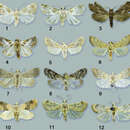Schacontia chanesalis: Brief Summary
(
англиски
)
добавил wikipedia EN
Schacontia chanesalis is a moth of the family Crambidae described by Herbert Druce in 1899. It is found in Mexico, Guatemala, Costa Rica and Venezuela.
The length of the forewings is 4.5–9 mm. The baso-costal triangle on the forewings is flanked by white scaling towards the inner margin and in the medial area, which is outwardly shaded brown. The postmedial area is greyish brown. The ground colour of the hindwings is white or very light grey, but darker postmedially.
Larvae have been reared from Podandrogyne decipiense.
- лиценца
- cc-by-sa-3.0
- авторски права
- Wikipedia authors and editors
Schacontia chanesalis: Brief Summary
(
виетнамски
)
добавил wikipedia VI
Schacontia chanesalis là một loài bướm đêm trong họ Crambidae.
- лиценца
- cc-by-sa-3.0
- авторски права
- Wikipedia tác giả và biên tập viên
Description
(
англиски
)
добавил Zookeys
(Fig. 2). Forewing length: 4.5–9.0 mm. Head - Ocelli and chaetosemata absent; proboscis reduced. Labial palpi porrect, extending slightly beyond clypeus. Frons conical; vertex and frons grayish brown, intermixed with white scales medially and along anterior bases of antennae. Thorax - Prothoracic collar light gray intermixed with gray-brown and white scales. Tegula and mesoscutum mostly gray, intermixed with light-gray and/or grayish-brown scales, the posterior apex of tegulae pale gray. Legs predominantly white, gray shading throughout foreleg; female with one pair of hind tibial spurs (medial pair absent). Forewing. Baso-costal triangle flanked by white scaling towards inner margin and in medial area, which is outwardly shaded brown (suffused with white basad). Postmedial area (between postmedial line and subterminal line) grayish brown. Subterminal line white; terminal line black, interrupted. Marginal scales brown. Basal area grayish brown traversed by a white band. Fringe scales light gray. Hindwing. Ground color white/very light gray, darker postmedially; postmedial lines grayish brown, white distally, conspicuous and common with FW. Subterminal area shaded darker brown; fringe white. Sc+R1 and Rs anastomosed slightly beyond dilated base of former. Male and female acanthae of frenulum fused from near base to apex to form one bristle. Abdomen - Ground color mostly dark gray intermixed with gray and light-gray scales above, white on undersurface. Tympanal organs (Fig. 22). As above for medalba group, vide supra. Male Genitalia (Figs 39, 40) - Tegumen divided dorsally into two dihedral or hemi-spherical “bubbles” that meet at a central sulcus, which divides anterior to base of uncus and forms a Y-shaped strut. Teguminal sulcus long, extending length of two teguminal lobes, such that anterior margin of tegumen appears emarginate, but not deeply invaginated. Uncus oblong, mucronate or miter-like, culminating in a distinct tip; concave or spatulate, setose on inner (ventral) surface. A membranous, more or less circular region at base of uncus positioned directly above (dorsal to) finger-like projection of gnathos, which also comprises a floating sub-tegumenal plate with four arms. Finger-like process arises from center of gnathos; dorsal pair of arms, which meet at juncture of uncus and tegumen, appearing to fulfill traditional description of gnathos by enveloping the anal tube, and the anterior pair extending ventrolaterally towards the vinculum, resembling a wishbone. Gnathos thus appears as a subtegumental (ventrad) suspension. Valvae reduced, broadly emarginate, bilobed; intrasaccular process a simple flange, denticled or rugose; subapical setal cluster near saccular margin. Costa robust, curved, appearing to arise near the respective vincular terminus. Juxta horseshoe-shaped, the base wider than the lateral “arms.” Phallus simple, moderately sclerotized throughout; cornuti absent. Female Genitalia (Fig. 41) - Papillae anales appressed; antrum apparent, chalice-like; ductus bursae short; corpus bursae elongate, without signa, caeca, or appendix bursae; ductus seminalis originating from posterior portion of corpus bursae. Ostium bursae with membrane between seventh and eighth segments.
- лиценца
- cc-by-3.0
- авторски права
- Paul Z. Goldstein, Mark A. Metz, M. Alma Solis
- библиографски навод
- Goldstein P, Metz M, Solis M (2013) Phylogenetic systematics of Schacontia Dyar with descriptions of eight new species (Lepidoptera, Crambidae) ZooKeys 291: 27–81
- автор
- Paul Z. Goldstein
- автор
- Mark A. Metz
- автор
- M. Alma Solis
Distribution
(
англиски
)
добавил Zookeys
Mexico, Guatemala; Costa Rica; Venezuela.
- лиценца
- cc-by-3.0
- авторски права
- Paul Z. Goldstein, Mark A. Metz, M. Alma Solis
- библиографски навод
- Goldstein P, Metz M, Solis M (2013) Phylogenetic systematics of Schacontia Dyar with descriptions of eight new species (Lepidoptera, Crambidae) ZooKeys 291: 27–81
- автор
- Paul Z. Goldstein
- автор
- Mark A. Metz
- автор
- M. Alma Solis

